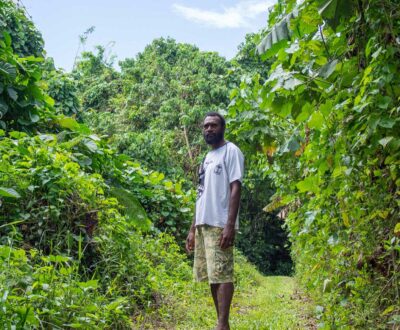‘Big lif’ (merremia) spells big problems for the forests of Vanuatu. Across the small Pacific nation, this invasive species has taken over disturbed forests, smothering trees and destroying healthy habitats for birds, insects and animals.
The Nakau program is working with Live & Learn Vanuatu and the community-owned Serthiac business who manage the Loru Conservation Area to better understand how managing merremia could create opportunities for carbon finance-supported conservation and restoration work by customary landowners.

Kaltabang Fred was the head ranger for Loru for six years. He says merremia is very powerful and that once it grows on a tree it will destroy it.
“Inside Loru Conservation Area, there are some trees that could die from big lif [merremia] so we [rangers] have a program to cut down the big lif to save the trees,” he explains.

A new feasibility study by Nakau has found there is potential for a payment for ecosystem services (PES) or stewardship program that supports the clearing of merremia thickets, forest restoration and the manual removal of merremia climbers from remnant forest. The study also concludes there is good potential for registering activities in Vanuatu that generate carbon revenue through management of merremia. Loru may be an important pilot site to explore this opportunity.
With costs of clearing merremia high, a cost-effective method is to focus first on removal of plants in remnant forest before the clearance of heavily affected land. Supporting a merremia management project in Loru would contribute to pilot research of this approach as a nature-based solution. Importantly, it would also enable more rangers to be employed.
“Early results show merremia is present in much of the forest at Loru, however in areas where it is dominant the forest condition is poor and at times declining, while flora and fauna diversity are also very low,” says Alex McClean.
He adds that “areas where merremia has been removed show a noticeable increase in forest condition and species diversity. This supports our proposal that a carbon benefit can be generated by managing merremia as a means of regenerating forests.”
Read the full story here.
The feasibility study and fieldwork is supported by Climate Resilient by Nature through the Australian Department of Foreign Affairs and Trade and WWF Australia in partnership with Live & Learn.
